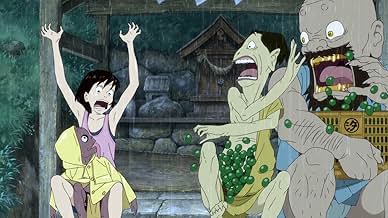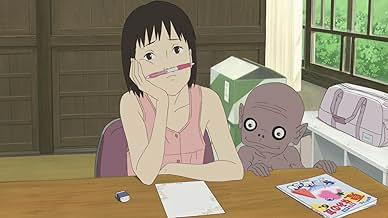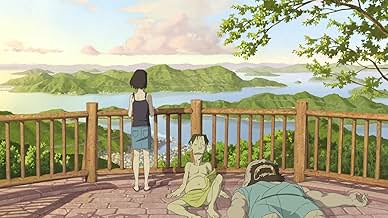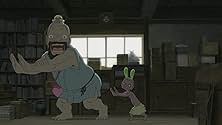11-year-old Momo moves with her mother to a small island town after her father dies. When she arrives, she encounters three goblins that others cannot see who try to help her to cope with th... Read all11-year-old Momo moves with her mother to a small island town after her father dies. When she arrives, she encounters three goblins that others cannot see who try to help her to cope with the loss of her father and the changes in her life.11-year-old Momo moves with her mother to a small island town after her father dies. When she arrives, she encounters three goblins that others cannot see who try to help her to cope with the loss of her father and the changes in her life.
- Awards
- 3 wins & 7 nominations total
- Momo Miyaura
- (voice)
- Ikuko Miyaura
- (voice)
- Iwa
- (voice)
- Kawa
- (voice)
- Great Auntie
- (voice)
- Koichi
- (voice)
- Umi
- (voice)
- Momo Miyaura
- (English version)
- (voice)
- Ikuko Miyaura
- (English version)
- (voice)
- Kazuo Miyaura
- (English version)
- (voice)
- Iwa
- (English version)
- (voice)
- Kawa
- (English version)
- (voice)
- Mame
- (English version)
- (voice)
- Great Uncle
- (English version)
- (voice)
Featured reviews
Their appearances are reminiscent of "Kyoka Hyakki Yakyo," an illustration of goblins in an Edo-era comic book called "Kibyoshi." "Kibyoshi" is a precursor of 'manga.' In the Edo era, various images of goblins entertained readers and told valuable lessons.
The film is set in Shio Shima, Inland Sea, an allusion to Yasujiro Ozu's classical film "Tokyo Story." Momo moves from Tokyo to the small island after her father's sudden death. While she is boarding a ship, three drops of spirits come down from the sky and land on her. The drops are the goblins or guardians, which help her reconcile a sad memory about her father. She regrets criticizing her father before he passed away.
In the film, the legendary goblins and Momo develop strange but warmhearted relationships that unite the past and present, or this world and afterlife. A motif of connectedness appears at various levels and creates a poignant but cheerful story. First, it shows continuation of time in Japanese popular culture by making a connection with the funny goblins emerging from a "kibyoshi" and in Momo's contemporary life. The past is linked to the present via 'manga.' The emergence of old 'manga'unfolds a history of Japanese popular culture, which intertwines with her daily life and symbolizes continuity.
Second, the connectedness illustrates the relationships between the spirits and humans in a spectacular way. Various types of spirits such as orchard spirits, ocean spirits and forest spirits assist Momo. This is most memorably exemplified when the spirits collaborate to help her in the midst of a fierce typhoon. Thanks to their support, she overcomes a difficulty. Demonstrating collective forces, the animating spirits generate a harmonious and splendid message that life is working with others. Nobody can live alone.
In addition, the scene also gives us a lesson. Each one of the vigorous spirits provides her with a tiny power that is almost negligible, but its contribution is valuable and finally brings a tremendous result to aid her. It reminds us that selfishness and indifference do not bring anything good. The significant message is that everybody has a role to play in the world. The scene is a pivotal moment of her spiritual growth.
Furthermore, the connectedness with the spirits also underlines a powerful animistic note that we are part of nature, which exerts enormous power and is larger than us. Nature and humans can coexist harmoniously in this world. The connectedness is the key that keeps our lives going.
Third, the connectedness demonstrates that death is not the end of life. The goblins have been sent from Above in order to watch over the living. Their special mission is to rally round Momo and report about her life to Above. Their mission expresses a vastness of time in human life, including the afterlife. In short, the dead also have a mission to do in this world. A person's life in this world is finite, but one receives another mission to complete in the afterlife. The amicable relationships between the hilarious goblins and her imply that the deceased can also return to this world and work together with the living. The connection between the dead and the living indicates a culture of ancestor worship, emphasizing the relationships between ancestors and offspring, or the past and present.
Accordingly, the story offers a strong viewpoint that it is possible that we can be befriended by spirits or the deceased. A sense of infinite life is an unforgettably emotional moment and contributes to her psychological relief that she has another chance to make up with her father. Finally, the togetherness ameliorates her hardship. All the connectedness is linked to a process of her reconciliation with her regret.
This film would be particularly appealing for victims of the unprecedented great earthquake and tsunami that struck Japan in 2011. Many people unexpectedly lost their loved ones and everyday lives. They were totally unprepared to suffer such tragedies, let alone time to bid farewell. Later, they left their familiar lands and have been struggling with new environments.
In the film, such sentiments are clearly illustrated. Momo's father had an accident at sea and never returned. Her relocation to Shio Shima is an outcome of the loss of her father. The abrupt loss echoes Japanese collective grief and sorrow for those affected by the unbearable incidents.
Likewise, Momo's struggle is part of their struggle. Her feeling of sadness is theirs; her tears are theirs. Eventually, her achievements foreshadow their hopefulness. The story captures her shuttered heart as a reflection of theirs. It epitomizes Japanese psychology – many people hesitate to talk about their tragedy because it is negative.
The film finally offers a moment of catharsis and kindles a flame of hope. Consequently, underlining the importance of familial bonds and hopes that keep them going toward their future, "A Letter to Momo" is a letter to those victims.
More importantly, the story conveys Japanese Gambaro spirit that is an encouragement for people to work hard. The spiritual essence cultivates a sense of esprit-de-corps and persistence. Gambaro spirit is a sense of working hard together and for others, who will help us sometime and somewhere.
Ultimately, intersecting beings from the afterlife with this world, the film informs us of a traditional belief that invisible spirits live together in this world in order to help us.
All the deceased are our guardians, so chin up!
This is Japanese anime so pure and yet so subtle that, if you watch for the entire two hours, it will slowly but inevitably overwhelm you.
Hiroyuki Okiura has lovingly and painstakingly done hand-drawn images which are deceivingly simple. You only have to pause the film and look closely at that you are seeing to appreciate the detail. Even the rice cooker in the kitchen is an exact match for an actual rice cooker.
The intent clearly was not to move into the more action-packed stories (space, time travel, wars) but to stick with the tried and true tale of a young girl connecting with nature spirits of a sort that are, again, unique to the culture. Very similar to My Friend Totoro, with more of an emotional step-laddering Personally, I loved it Give it a chance and you may be crying by the end.
That goes for the ladies too
In A Letter To Momo, a young girl Momo and her mother have sold up their apartment in Tokyo and gone to live near some relatives on Shio Island. Momo's father has just died in a boating accident, and an unfinished letter that opens only with 'Dear Momo...' doesn't bring about the kind of closure the young girl needs. Three drops of rain from the sky however accompany Momo to the island, where they take the form of ghostly goblins from an old picture-book.
Even though the creatures can only be seen by Momo, the trick with anime films of this kind is that the viewer needs to be drawn into Momo's view of the world, not seeing the line between fantasy and reality, letting the message that lies behind it weave a magic spell without being overstated. That of course if the cinematic art of illusion and A Letter To Momo does this particularly well, creating good interaction between the characters, exploring the opportunities for visual effects, and building it all up to towards an epic conclusion that gets message across sensitively, without preaching or speaking down to a younger audience.
The art/animation in this movie is top-notch. Production I.G. with assistance from P.A. Works, Studio Pierrot, and CG by Dandelion resulted in stunning visual quality down to the tiniest details. What I especially liked, was the amount of attention paid to body language and gestures. There's so much information to be gleaned from subtleties of the visuals alone, and that's what I find most interesting about Japanese films. There was also this action sequence near the end that just blew me away. I don't want to spoil, but I have not seen such breathtaking hand-drawn animation since watching "Tonari no Totoro" in the late '80s.
The story begins with the protagonist, Momo, moving to a small fictional island named Shiojima with her mother. Their new house appears to be haunted, and she feels absolutely miserable about moving out of Tokyo. Being a city girl that she is, Momo struggles to adjust to the country life. Instead of playing with the local kids, she eventually befriends three Youkai in her house - Iwa, Kawa, and Mame. Momo begins to appreciate the life on the island, and come to realize the meaning of his late father's unfinished letter to her.
The character development in this movie is absolutely phenomenal. It begins with a light comedy, but through numerous adventures and mishaps on the island, we slowly learn about her past. The transition from comedy to drama is seamless, and it really makes you to care about the protagonist by the end... This film has what I call magic, something Ghibli films of late desperately lack. Although the local kids were severely underused in this movie, the three Youkai were the true supporting cast. Their chemistry with the protagonist was excellent, and the humor just comes naturally. Mame's character was especially funny in a quirky way. One can easily tell how much thought and planning has been put into this film just by watching the impeccable timing at which Mame's character was used as comedic relief every single time.
Every piece of music appears to be fully orchestrated, especially the violins stood out to build tension in action scenes. Momo's voice acting by child actress and seiyuu Miyama Karen was a perfect fit, as well as the three Youkai.
"A Letter to Momo" is almost like a homage to Studio Ghibli's kids movies - "My Neighbor Totoro", "Spirited Away", and "Ponyo". It sticks to the tried and tested formula of supernatural spirits that only interacts with kids, and somewhat predictable plot development. However, the producers have managed to merge various elements from all those films into an exciting original story. "A Letter to Momo" is a magical crowd-pleaser with great pacing and a heartwarming story. It's a solid movie that anime and movie fans should not miss.
Did you know
- Quotes
Momo Miyaura: [last words to her father] You're selfish, and you're a liar. I don't care if you come back.
- SoundtracksUruwashi Mahoroba: Utsukushiki Basho
(Uruwashi Mahoroba: Beautiful Place)
Lyrics & Music by Yûko Hara
Arranged by Jun'ichi Soga & Yûko Hara
Strings Arrangement by Yûko Hara
Performed by Yûko Hara
- How long is A Letter to Momo?Powered by Alexa
Details
- Release date
- Country of origin
- Official sites
- Language
- Also known as
- A Letter to Momo
- Production companies
- See more company credits at IMDbPro
Box office
- Gross US & Canada
- $71,712
- Opening weekend US & Canada
- $4,596
- Jul 27, 2014
- Gross worldwide
- $6,774,529
- Runtime
- 2h(120 min)
- Color
- Sound mix
- Aspect ratio
- 1.85 : 1




























